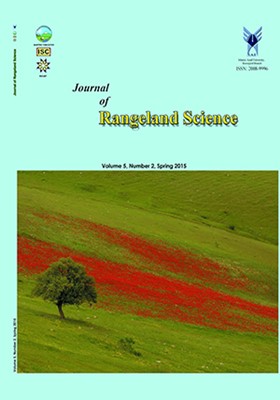Assessment of the Monthly Water Balance in an Arid Region Using TM Model and GIS (Case Study: Pishkouh Watershed, Iran)
محورهای موضوعی : Relationship between Animal and RangelandJalal Barkhordari 1 , Ali Asghar Semsar Yazdi 2
1 - Faculty Member, Agricultural Natural Resource Reserch Center of Yazd, Iran
2 - Assistant Professor, Director of International Center on Qanats and Historic Hydraulic Structures (ICQHS)
کلید واژه: Pishkouh watershed, Geografhic Information Systems, TM model, Water Balance, Water deficit, Water surplus,
چکیده مقاله :
Monthly discharge is one of the most important factors considered in designs and hydrological works. Some watersheds are not equipped with needed hydrometric equipment. In such a case average monthly discharge could be estimated from regional monthly water balance models of representative watersheds. In this study, Thornthwaite & Mather (TM) model were used in the Pishkouh watershed in arid climate of Yazd, Iran. The water balance was used for computing seasonal and geographical patterns of water availability to facilitate better management of available water resources. The water balance study using the TM model with the help of remote sensing and Geografhic Information Systems (GIS) is very helpful in finding out the periods of moisture deficit and moisture surplus for an entire basin. This study indicates that there is an annual deficit of 442.7 mm in the study basin and an annual surplus of 26.4 mm. The Pishkouh watershed has a period of moisture surplus from June to August and the remaining months are a period of deficit. Generally these mean estimated runoff values fall between the 90% confidence intervals for the measured runoff and quality of the model was satisfactory (Qual=2.86). These results indicate that the TM model can be satisfactorily applied to estimate mean monthly stream flow and potential runoff map in the arid regions of central Iran, too.
Barkhordari, J., 2013. The Calculation of potential Runoff and Selection of the Sites for Underground Dams in Yazd region of Iran (with use of RS, GIS and DSS), Ph.D. thesis, Yerevan State University, P.151.
Barkhordari, J. and Vartanian, T., 2012. Using Post-classification Enhancement in Improving the Classification of Land use/cover of Arid Region (A case study in Pishkouh watershed, Center of Iran). Jour. rangeland science, 2(2): 459-465.
Hamon, W. R., 1961. Estimating potential evapotranspiration: Jour. the Hydraulics Division, Proceedings of the American Society of Civil Engineers, 87: 107-120.
Jasrotia, A.S., Majhi, A. and Singh, S., 2009. Water Balance Approach for Rainwater Harvesting using Remote Sensing and GIS Techniques, Jammu Himalaya, India. Water Resource Manage, DOI: 10.1007/s11269-009-9422-5, p
Mahdavi, M. and Azarakhshi, M., 2004. A determination of an appropriate monthly water balance in small watershed of Iran. Natural Res. Jour, Iran, 57(3): 415-427, (In Persian).
McCabe, G. J. and Markstrom, S. L., 2007. A monthly water-balance model driven by a graphical user interface: U.S. Geological Survey Open-File report, 1088, P.1-6
McCabe, G.J., and Wolock, D.M. 1999. Future snow pack conditions in the western United States derived from general circulation model climate simulations: Jour. the American Water Resources Association, 35 (1): 473- 484.
Organization of Forest and rangeland, 2004. Soil survey of Pishkouh watershed, Report of Natural resource office in Yazd, unpublished, P.80. (In Persian).
Singh, R. K. and Hariprasd, V, 2003. Remote sensing and GIS approach for assessment of the water balance of a watershed. Hydrological Sciences Jour. Des. Sciences Hydro., 49(1): 131-141.
Sen, P. K. and Gieske, A, 2005. Use of GIS and Remote Sensing in Identifying Recharge Zones in a semi-Arid Catchments: A case Study of River Basin, Portugal. Jour. Nepal Geological Society.31: 25-32.
Thornthwaite, C. W, 1948. An approach toward a rational classification of climate: Geographical Review, 38: 55–94.
Vandewiele, G. L., Chong XU, and Ni-lar-Win., 1992. Methodology and Comparative Study of Monthly water Balance Models in Belgium, China, Burma, Jour. hydrology, 43: 317-347.


